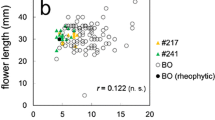Abstract
The biological analysis of six populations ofAsphodelus tenuifolius and 12 populations ofA. fistulosus has confirmed that they are separate species. Both their floral structures (length of the tepals, stamens, anthers and style) and also their pollen size are clearly different.A. tenuifolius has only the 2n = 28 chromosome race, whileA. fistulosus has 2n = 28 and 2n = 56.A. tenuifolius is genetically less variable thanA. fistulosus and they have different electrophoretic mobilities. Gene duplication phenomena exist in the 2n = 28 level of both species.
Similar content being viewed by others
References
Arcangeli, G., 1894: Compedio della Flora Italiana. 2nd edn. — Torino, Roma.
Barros-Neves, J., 1973: Contribution à la connaissance cytotaxinomique desSpermatophyta du Portugal. 8.Liliaceae. — Bol. Soc. Brot. (ser. 2)47: 157–212.
Bjorqvist, I., Bothmer, R. von, Nilsson, O., Nordenstam, B., 1969: Chromosome numbers in Iberian angiosperms. — Bot. Not.122: 271–283.
Boissier, E., 1882: Flora Orientalis, 5/1. — Genevae, Basileae.
Borgen, L., 1969: Chromosome numbers of vascular plants from the Canary Islands, with special reference to the occurrence of polyploidy. — Nytt. Mag. Bot.16: 18–221.
Dahlgren, R., Karlsson, TH., Lassen, P., 1971: Studies on the flora of the Balearic Islands. 1. Chromosome numbers in Balearic angiosperms. — Bot. Not.124: 249–269.
Durand, TH., Schinz, H., 1895: Conspectus florae Africanae, 5. — Bruxelles.
El-Gadi, A., 1978:Liliaceae. — InJafri, S. M. H., El-Gadi, A., (Eds.): Flora of Libya 57. — Tripoli: Al Faateh University.
Erdtman, G., 1960: The acetolysis methods. — Svensk Bot. Tidskr.54: 561–564.
—, 1966: Pollen morphology and plant taxonomy (angiosperms). — New York: Hafner.
Fiori, A., 1923: Nuova flora analitica d'Italia 1. — Firenze.
Hayek, A., 1933: Prodromus florae peninsula Balcanicae 3. — Berlin: Markgraf.
Lange, J., 1860–1865: Pugillus plantarum imprimis Hispanicarum, 1. — Kjøbenhavn.
Maire, R., 1958: Flore de l'Afrique du Nord, 5. — Paris: Paul Lechevalier.
Nilsson, Q., Lassen, P., 1971: Chromosome numbers of vascular plants from Austria, Mallorca and Yugoslavia. — Bot. Not.124: 270–276.
Pignatti, S., 1982: Flora d'Italia 3. — Bologna: Edagricole.
Pluym, A. van der, Hideux, M. J., 1977: Application d'une methodologie quantiative á la palynologie d'Eryngium maritimum (Umbelliferae). — Pl. Syst. Evol.127: 55–85.
Quezel, P., Santa, S., 1962: Nouvelle flore de l'Algérie. — Paris: C.N.R.S.
Rechinger, K. H., 1982 (Ed.): Flora Iranica, 151. — Graz: Akademische Druck- u. Verlagsanstalt.
Richardson, I. B. K., Smythies, B. E., 1980:Asphodelus L. — InTutin, T. G., & al., (Eds.): Flora Europaea 5: 17. — Cambridge: Cambridge University Press.
Ruiz Rejon, M., 1976: InLöve, A., (Ed.): IOPB chromosome numbers reports 52. — Taxon28: 341–342.
—,Oliver, J. L., 1980: Cytogenetic and electrophoretic evidence for ancestral polyploid origin of basic chromosome number x = 14 of the genusAsphodelus (Liliaceae). — Pl. Syst. Evol.136: 259–265.
Selander, R. K., Smith, M. H., Yang, S. Y., Johnson, W. E., Gentry, J. B., 1971: Biochemical polymorphism and systematics in the genusPeromyscus. 1 Variation in the old-field mouse (Peromyscus polionotus). — Univ. Texas Publ.7103: 49–90.
Stebbins, G. L., 1971: Chromosomal evolution in higher plants. — London: Edward Arnold.
Täckholm, V., 1974: Students flora of Egypt, 2nd edn. — Cairo: Cairo University.
Willkomm, M. 1862:Liliaceae. — InWillkomm, M., Lange, J., (Eds.): Prodromus florae Hispanicae.1: 200–221. — Stuttgart.
Author information
Authors and Affiliations
Rights and permissions
About this article
Cite this article
Rejon, C.R., Blanca, G., Cueto, M. et al. Asphodelus tenuifolius andA. fistulosus (Liliaceae) are morphologically, genetically, and biologically different species. Pl Syst Evol 169, 1–12 (1990). https://doi.org/10.1007/BF00935979
Received:
Revised:
Issue Date:
DOI: https://doi.org/10.1007/BF00935979




